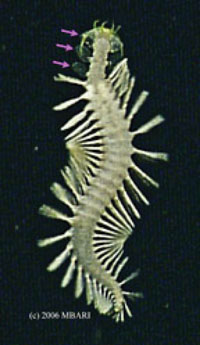|

'Green
bombers'
from the deep sea
In the latest proof that the oceans continue to offer remarkable
findings and much of their vastness remains to be explored, scientists
at Scripps Institution of Oceanography at UC San Diego and their
colleagues have discovered a unique group of worms that live in the
depths of the ocean.
The discoveries feature worms nicknamed "green bombers" that can
release body parts that produce a brilliant green bioluminescent
display.
The discovery is described in the August 21 issue of the journal
Science and is led by Karen Osborn of Scripps Oceanography.

The researchers introduce seven previously unknown species of
swimming worms in the annelid phylum ranging from 18 to 93 millimetres
(.7 to 3.6 inches) in length.
They were discovered by the scientists using remotely operated
vehicles at depths between 1,800 and 3,700 meters (5,900 and 12,140
feet).
The first species described in the paper has been given the
scientific name Swima bombiviridis, referring to its swimming ability
and the green bombs.
Osborn says one key aspect of the discoveries is that the newly found
worms are not rare. Opportunities to witness such animals and collect
and study them, however, have been extremely rare.
"We found a whole new group of fairly large, extraordinary animals
that we never knew anything about before," said Osborn, a post-doctoral
researcher in the Marine Biology Research Division at Scripps.
"These are not rare animals. Often when we see them they number in
the hundreds. What's unique is that their habitat is really hard to
sample." Largely transparent except for the gut area, the worms propel
themselves with fans of long bristles that form swimming paddles.
"The depths between 1,000 and 4,000 meters (3,280 and 13,120 feet)
form the biggest habitat on Earth and also the least explored," said
Scripps Professor Greg Rouse, a coauthor of the paper and curator of
Scripps Benthic Invertebrate Collection.
"With fairly limited time on submersible vehicles, mainly off
California, we've picked up seven new species.
It goes to show that we have much more exploration ahead and who
knows what else we'll discover?" Each of the species features a variety
of elaborate head appendages.
Five of them are equipped with luminescent structures, the "bombs,"
that are fluid-filled spheres that suddenly burst into light when
released by the animal, glowing intensely for several seconds before
slowly fading.
Due to the bright lights of the submersible, scientists were not able
to witness bomb-casting in the worm's natural habitat, but rather on
ships after the animals were captured.
While the scientists speculate that the bombs are used as a defensive
mechanism against potential predators, more studies are needed to fully
understand the process.
Rouse says the green bombers in the newly discovered clade, (a common
ancestor and all its descendant organisms), are fascinating from an
evolutionary standpoint. Looking closely at their relatives that live on
the seafloor, it appears the bombs were once gills that evolutionarily
transformed over time.
"The relatives have gills that appear to be in exactly the same
places as the bombs," said Rouse. "The gills can fall off very easily so
there's a similarity of being detachable, but for some reason the gills
have transformed to become these glowing little detachable spheres."
Osborn continues to probe many of the various adaptations the worms
have made since evolving into swimming species. The challenges faced by
animals living in a three-dimensional open water habitat above the
seafloor are very different than those faced by animals living on the
seafloor.
These include locating new food sources, finding ways to maintain
optimal depth and grappling with predators that come from various
directions.
"I'm interested in how animals have evolved in the water column,"
said Osborn. "These worms are great examples. How does a worm transform
into a wonderful glowing animal?" In addition to Osborn and Rouse,
coauthors of the Science paper include Steven Haddock of the Monterey
Bay Aquarium Research Institute, Fredrik Pleijel of the University of
Gotteborg in Sweden and Laurence Madin of the Woods Hole Oceanographic
Institution (WHOI).
The research was supported by Scripps Institution of Oceanography, a
University of California President's Postdoctoral Fellowship, the David
and Lucile Packard Foundation, NOAA, WHOI and the National Geographic
Society.
Science Daily
Name: S.M. Dasuni Isha
Waidyarathna
Gender: Female
Age: 11
School: A/Niwanthakachethiya
MV
Hobbies: Collecting
stamps, reading books
Pen-pals preferred from:
Sri Lanka, India, Japan and Canada
Age group: 11-16
Address: No. 695,
Mihinthala Road, Jaffna Junction, A/pura, Sri Lanka
****
Name: M. Madusha Sandamali
Gender: Female
Hobbies: Gardening,
reading novels, collecting stamps
Pen-pals preferred from:
England, Oman
Age group: 10-13
Address: No. 120,
Nidangala, Kotavila, Kamburugamuwa, Sri Lanka
****
Name: Shinie Upeksha
Balasooriya
Gender: Female
Age: 13
School: Maliyadeva Balika
Vidyalaya, Kurunegala
Hobbies: Reading story
books, writing poems, drawing, playing with friends, listening to music
Pen-pals preferred from:
USA, Japan, India, America, England, Sri Lanka, China, Germany,
Australia
Age group: 13-20
Address: No. 214/6, Kandy
Road, Kurunegala, Sri Lanka.
****
Name: Shashikala
Chathurangi Matara Arachchi
Gender: Female
Hobbies: Reading adventure
story books, watching movies, listening to songs, playing computer games
and the violin
Pen-pals preferred from:
Sri Lanka, India, USA, UK, Australia, Canada, Germany, New Zealand or
any other country
Age group: 16-22
Address: 2nd Mile Post,
Kandagahavila, Payagala, Sri Lanka.
****
Name: Yashoda Kalpani
Hettiarachchi
Gender: Female
Age: 13
School: Mahamaya Girls'
College
Hobbies: Reading books,
drawing, watching TV, chatting with friends, swimming, listening to
music, travelling, dancing
Pen-pals preferred from:
Sri Lanka, India, Canada, Australia, England, Germany, New Zealand,
Singapore
Age group: 11-16 (girl's
only)
Address: 53/11, Hewahata
Road, Thalwatta, Kandy, Sri Lanka. |

